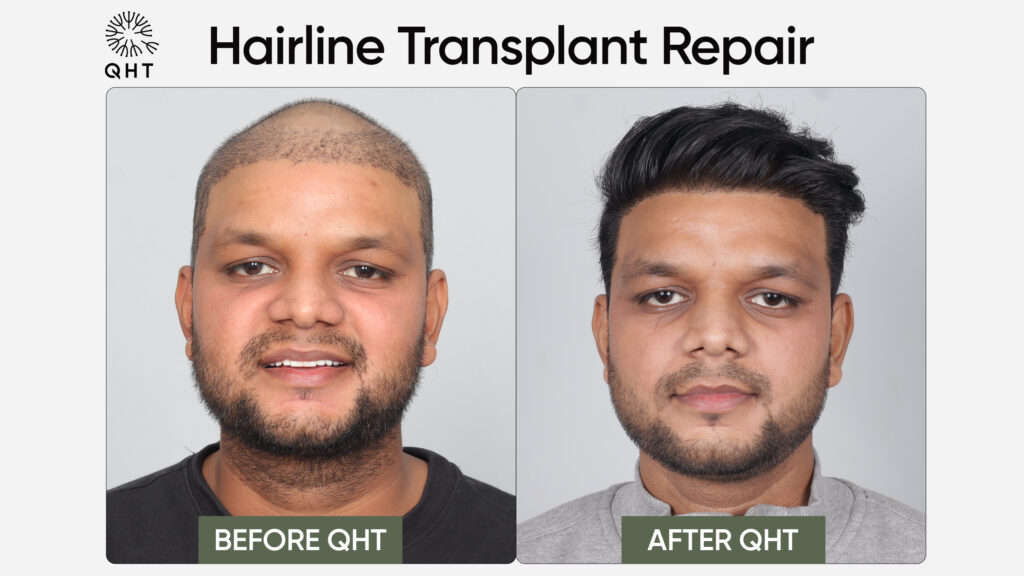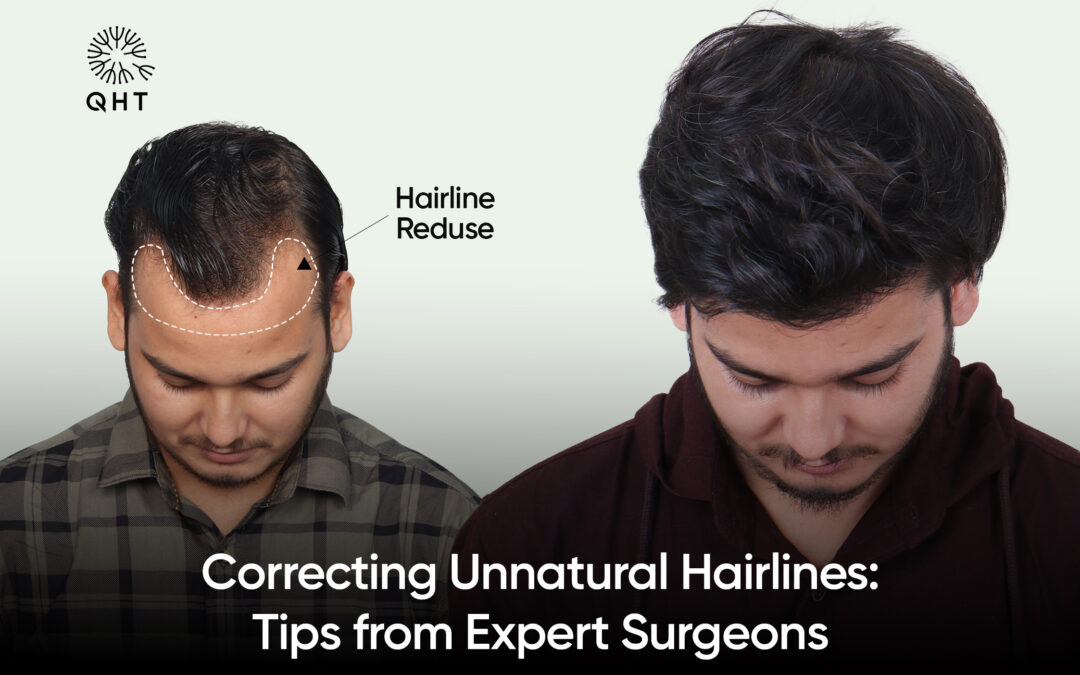When a hair transplant is done properly, it can make a significant difference to how one looks. But, when it fails the disappointment is equally overwhelming. An unnatural hairline is one of the most frequent problems the patients experience and it appears to be hair in a strange place. And the best thing is that modern surgeons at clinics like QHT Clinic have developed methods to offer an unnatural hairline repair that transforms unacceptable outcomes into a realistic-looking hair transplant that restores harmony and self-worth. This blog will discuss the causes of unnatural hairlines, what experts can do to correct unnatural hairlines, and tips that can be used by professionals to get natural and long-lasting results.
Why Does Hairline Matter?
The hairline encircles the face and contributes a lot to the look. The hairline is designed in such a way that it immediately shows that something is not natural even when the rest of the hair transplant looks full and healthy.
Symptoms of unnatural hairline are:
- Straight ruler-like, without natural irregularity.
- The hairline is either excessively low or excessively high on the forehead.
- Large grafts result in a pluggy and dollish appearance.
- Wrong hair direction/angle.
- The patchy appearance of the line is created by uneven density.
Such issues can be discouraging and with the help of hairline transplant repair, they can be fixed.
Cause of Unnatural Hairlines
One of the reasons why hairline issues are common is due to improper planning or due to the use of old-fashioned techniques. The main reasons include:
1. Poor Design Choices
Unless the surgeon takes into consideration age, face shape, or permanent hair loss, the hairline will appear unnatural with time.
2. Outdated Techniques
In the older techniques, large plugs or mini-grafts were used to produce a clumped, unnatural effect instead of a feathered transition.
3. Incorrect Angle of Growth
There are angles at which natural hair grows. When grafts are inserted too straight or at an oblique angle, the appearance is stiff.
4. Bad Density Planning
A very thick line appears synthetic and a thin line appears incomplete. A balanced approach is vital.
5. Inexperience
There are numerous unnatural outcomes related to a shortage of surgeon experience.
The fastest or least expensive clinics tend to compromise on artistry and accuracy and, as a result, cause issues that need a hairline solution in the future.
Hairline Transplant Repair Experts

The positive news is that the latest methods enable the surgeons to fix the majority of unnatural outcomes. The major tactics are:
1. Hairline Redesign
A new design is sketched, corresponding to the age and gender of the patient and to the balance of the face. This can often be achieved by moving the line slightly higher or making slight changes.
2. Graft Extraction and Redistribution
FUE can be used to very carefully remove pluggy grafts or misplaced follicles and then reinsert them strategically.
3. Scalp Micropigmentation (SMP) Supportive
SMP has the ability to cover the scars or fit a small gap with pigment which will increase the appearance of density.
4. Advanced FUE and FUT Methods
Current methods permit accurate excision and reconstruction, to reduce scarring and to enhance natural outcomes.
At QHT clinic, a team of expert surgeons work on your hairline to help you achieve the best results.
The Aesthetic Side of Hairline Repair
Repair surgery is more than medical skill, it is an art. Surgical tools use the following principles:
- Unnaturalness in the name of Realism: An irregular boundary respects natural expansion.
- Soft Transition Area – The front ones are fine, and the back ones are thicker.
- Age-Appropriate Design: The patient has a natural appearance in accordance with her life stage.
- Balanced Symmetry: Both sides are not too similar.
This science and art combination produces the most natural hair transplant ever.
What Patients Should Expect During Repair
Consultation
The surgeon evaluates the transplant that has been done before, the supply of the donor and the objective of the patient. There is frequent use of digital simulations.
Procedure
- Step 1: Debridement of unnatural grafts where needed.
- Step 2: New grafts are taken out either by FUE or FUT.
- Step 3: Designing and re-implantation of a more natural and soft hairline.
Recovery
The second transplant is generally less painful to recover from. The results are usually visible in 9 -12 months.
Tips to Get a Natural Hairline
- Choose an Experienced Surgeon: In all cases, look at the before and after repair outcomes.
- Value Naturalness: Naturalness is superior to the overload of density.
- Be Patient: Depending on severity, it may take several sessions to repair.
- Protect Donor Hai: Donor supply is minimal; planning is important.
- Follow Aftercare Strictly: Effective post-op care is the key to graft survival.
How to Avoid The Need To Repair?
To avoid an unnatural outcome, it is best to make prudent decisions in the first place:
- Do not accept cheap offers from inexperienced providers.
- Make sure it is modern FUE or FUT.
- Select a hairline design that is appropriate for the age.
Mental Effect of an Artificial Hairline
Even a bad transplant not only changes the look, but it also hurts self-esteem. Most patients are remorseful, anxious or embarrassed. Social and professional life can also suffer as a result of the stress of concealing a bad hairline.
However, corrective surgery is commonly life-changing. Patients report that their unnatural hairline fix is not only cosmetic, but it also gives back self-esteem and emotional balance.
Alternative to Repair Surgery
Not every patient needs surgery to fix an unnatural hairline. Options can be:
- SMP (Scalp Micropigmentation) of scar or gap.
- Laser to make scars less visible with plugs.
- Makeup to wear before surgery or a hairpiece.
Nevertheless, hairline transplant repair is the gold standard of lasting results.
Frequently Asked Questions
1. Is it possible to repair all unnatural hairlines?
All of them can be repaired with modern methods, but the outcomes are dependent on the availability of donor hair.
2. How much longer do I have to wait to see results after repair?
The first change is shedding, although the natural results are usually noted in 9-12 months.
3. Does repair surgery become more difficult than the initial transplant?
Yes, it takes more skill to make them work again, but recovery is generally the same or less complex than the original procedure.
4. Will I be able to see scars following a repair?
In modern FUE, the scarring is less and in most cases cannot be seen once the hair has grown.
5. Do women also get hairline repair surgery done?
Yes, repair procedures can be used with women who have unnatural or uneven transplants.
Conclusion
The unnatural hairline is devastating and the modern methods of hair restoration are also highly effective. It can be redesigned, softened, and restored using an unnatural hairline fix or full hairline transplant repair with the right surgeon. At reputed centers such as QHT Clinic, the trick is to use both technical skills and art skills to create a natural-looking hair transplant that matches the face and brings back confidence. After all, it is not merely a matter of appearance to fix an artificial hairline, but rather a matter of restoring identity, balance, and confidence.
Visit Our QHT Clinics Near You
Looking for the best hair transplant guidance? Our expert team is ready to help you at any of our clinics:
Haridwar
521, Model Colony, Ranipur More, Haridwar, Uttarakhand – 249407
Delhi
D-15, Outer Ring Road, above Federal Bank, Prashant Vihar, Sector 14, Rohini, New Delhi – 110085
Hyderabad
Opposite Hotel Park Hyatt, Road No. 2, Banjara Hills, Hyderabad, Telangana – 500034
Noida (Corporate Office)
3rd Floor, C Block, Phase 2, Industrial Area, Sector 62, Noida, Uttar Pradesh – 201309

